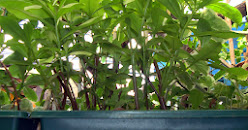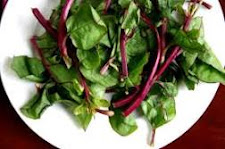Common Home Vegetables and Spices Grown in the Tropics: Malunggay, Onion, Kamote, Garlic, Talinum, Alugbati, and Others
Dr Abe V Rotor
With Ms Melly C Tenorio, host
"Gardening is truly rewarding. Other than food and nutrition we get, it is a hobby and therapy. It is environment-friendly."
1. Malunggay is the most popular tree vegetable
in the tropic.
Compound leaves of malunggay (Moringa oleifera); botanical description of malunggay; mature pods hanging on the tree. (Reference: Useful Plants of the Philippines by WH Brown)
In the province no home is without this small tree at the backyard or in a vacant lot. The leaves, flowers, juvenile pods and young fruits of Moringa oleifera (Family Moringaceae) go well with fish, meat, shrimp, mushroom, and the like. It is one plant that does not need agronomic attention, not even weeding and fertilization, much less chemical spraying. You simply plant an arms length cutting or two, in some corner or along the fence and there it grows into a tree that can give you a ready supply of vegetables yearound. What nutrients do we get from malunggay?
Here is a comparison of the food value of the fresh leaves and young fruits, respectively, in percent. (Marañon and Hermano, Useful Plants of the Philippines)
· Proteins 7.30 7.29· Carbohydrates 11.04 2.61· Fats 1.10 0.16· Crude Fiber 1.75 0.76· Phosphorus (P2 O 5) 0.24 0.19· Calcium (CaO) 0.72 0.01· Iron (Fe2O3) 0.108 0.0005
Owing to these properties and other uses, rural folks regard malunggay a “miracle tree.” Take for example the following uses.
· The root has a taste somewhat like that of horse-radish, and in India it is eaten as a substitute to it.· Ben oil extracted from the seed is used for salad and culinary purposes, and also as illuminant.· Mature seeds have antibacterial and flocculants properties that render drinking water safe and clear.
From these data, it is no wonder malunggay is highly recommended by doctors and nutritionists for both children and adults, particularly to nursing mothers and the convalescents.~
Part 2 - Onion Leek


This is one way to encourage kids to have a daily supplement of vegetables. Vary the use of leek in their diet. Onion leek is rich in vitamin K, A, C and B6, manganese, folate, iron, fiber, magnesium, molybdenum, copper, calcium, and potassium. It also contains thiamine, riboflavin, and niacin, and antibiotic substances like Allicin and Alliin - from Allium, the genus of onion (A. cepa), garlic (A. sativum), kutchay (A tuberosum), and the original leek (A. ampeloprasum). Leeks generally have also high calorie value, and fair amounts of protein and fat. It is no wonder onion is the most important vegetable in the world.


Grow leek where there is sufficient sunlight, preferably on an elevated place. It's easy to grow leek from shallot (Sibuyas Tagalog) and from bulb onions (Granex or Creole). Staggered planting assures continuous supply of leek for the family - and for neighbors too.
A pot of onion leek makes a unique gift to friends who love to cook, those in their senior years, and those convalescing. Don't forget to add a little ribbon and a personal message. Make this as project in school and community. ~
Part 3 - Practical Hydroponics - Kamote Tops
Three-week old kitchen garden of sweet potato (kamote) tops
Fill to three-fourth a convenient glass jar with tap water. Place a healthy tuber on the mouth of the jar. To keep it steady, stick three pieces of toothpick like a tripod. Add water daily as roots develop. Be sure to replace water weekly to prevent mosquitoes from breeding in the jar.
In a week's time or two you can start harvesting. At first allow the tops to extend. Just clip the leaves you need in your cooking. Rotate the position of the tuber towards the source of light, so that you will have more shoots, and greener and bigger leaves.
Now you have a dish garden for a whole month or longer. You can grow fresh onion leaves with this technique. Try it on garlic.
You see, this is simple hydroponics - soil-less gardening. It is introduction to the science of hydroponics and aeroponics. For school children, why don't you try this as your project?
Read more about hydroponics and aeroponics. Happy gardening!
It is a vegetable all year round. In summer kamote is grown in the fields and gardens for its enlarged roots or tubers which are rich in carbohydrates (go food) and rich in protein (grow food). In the habagat, it grows wild and luxuriant on hilltops, on levees and dikes, on the uplands, covering wide areas, keeping weeds down and protecting the soil from erosion.
Kamote tops make an excellent dish with mungo and pork, bulanglang with shrimp or fish, and mushroom, or cooked in other recipes, or served as salad, blanched with red, ripe tomatoes and sliced onions, with a dash of salt, or a dip of fish sauce - bagoong or patis. Or cooked in tinola in place of pepper leaves, and green papaya. Why not blanch the tops on rice in its final stage of cooking? Add bagoong squeezed with calamansi or lemon.
Kamote tops, maligned for being a poor man's food, rise to the apex of the food pyramid, top the list health programs, and doctors' prescription. Kamote tops occupies the rank of malunggay, alugbati, talinum, and spinach, relegating lettuce and other crucifers - cabbage and cauliflower and pechay - to the backseat.
Kamote tops are safe to health and the environment because they don't carry residues of pesticides applied on the field on many crops, and also those of toxic metals like lead, mercury and cadmium. Damaged parts are simply discarded, harvesting only the succulent and healthy leaves for further safety and better presentation.
Kamote tops come in green and purple, characteristic of the plant varieties, but in both cases, the same nutritive values are derived, with some advantage from the purple variety which contains xanthophyll in addition to chlorophyll. Both are recommended for anemic persons for their high iron content, and to those suffering from poor bone development, poor eyesight, and poor metabolism.
Kamote tops are used as planting materials, a case of cloning in the plant world, each stem becoming a new plant rejuvenated and true to type genetically - and younger than the parent source. The new plant is capable of carrying all processes that constitute the plant's cycle. It is a phenomenon known in variable observations in the living world, which heretofore remains unsolved by science.
Beauties come naturally with good food, simple and active lifestyle, in the rural areas where sunshine, clean air and surrounding, make a perfect combination from which spring the true beauty of man and woman, as compared to the makeup beauty from cosmetics, expensive salons, and by the so-called wonders of science and technology like liposuction and surgery. Why can't we simply eat kamote tops more often?
Part 4 - Garlic Sprouts, Anyone?
Husked cloves of garlic sprouted in a refrigerator, 10 to 20 degrees Celsius (vegetables shelf), for a period of two weeks.
Sprouted garlic has higher anti-oxidant properties. This process is cleaner than directly sprouting garlic exposed to sunlight. Ref-sprouted garlic sprouts develop chlorophyll and turn green just after a few hours of indirect sunlight. Conventional garlic sprouts are green, harvested from germinating bulbs. or bulbs raised in the garden or pots. These are popularly called garlic shoots. Ideally, their flavor is best appreciated eaten fresh. Garlic sprouts are excellent on top of baked potatoes, green salads, vegetable salads, or stirred into egg salads, pasta salads, dips, and garnish. (Photos taken from actual result of home experiment in the author's residence.Part 5 - Talinum in Pots
(Talinum fruticosum = T. tiangulare).
Other names: Ceylon spinach, Fame flower, Surinam Purslane. While it is cultivated as a leafy vegetable in Africa and South and Southeast Asia, it generally grows as an annual weed in fields and gardens during the monsoon season. .
Potted talinum at home
You may buy ready made garden pots (photos). Be sure they fit into the place like window sill, fence, patio, and other locations where the plant receives adequate sunlight, and is safe from animals, sudden changes of weather, and pollution.
 On reaching 4 to 6 inches, harvest the succulent shoots, wait for new shoots to develop for the next harvest, at two weeks interval. Replace spent soil with new garden soil, preferably with compost, after 4 or 5 harvests. Staggered planting schedule in different pots will assure a continuous supply of fresh talinum year round.
On reaching 4 to 6 inches, harvest the succulent shoots, wait for new shoots to develop for the next harvest, at two weeks interval. Replace spent soil with new garden soil, preferably with compost, after 4 or 5 harvests. Staggered planting schedule in different pots will assure a continuous supply of fresh talinum year round. Author with talinum harvest. Pick only the leaves and let the shoots to grow new leaves. If you wish to have more shoots, harvest the succulent tops, like kamote tops.
Part 6- Alugbati - Versatile Leafy Vegetable
There are three common types of alugbati: Basella alba with green stem and oval to almost round leaves; Basella rubra with red stems and green, oval to round leaves; and a third type, which is a hybrid of the two.
Ginisang alugbati with pork is a popular dish among Filipinos. The easiest preparation is steamed salad with tomato, onions and a dash of salt.
At home, we cook alugbati with ground mungo, with pork or fish (roasted tilapia or hito). "Ulam na, sabaw pa." When conditions are pressing, ginisang alugbati with sardinas is a good alternative. There are other culinary preparations found in the cookbook, local and foreign.
Part 7 - Other Local Vegetables
Himba-ba-o or Alokong (Alleanthus luzonicus)
Male flowers of squash (Cucurbita maxima)
Bagbagkong (Telosma procumbens [Blanco] Merr.)
NOTE: Add to this list other common food plants growing in your community. Make this topic a subject of research for your school and community.






0176.JPG)















No comments:
Post a Comment